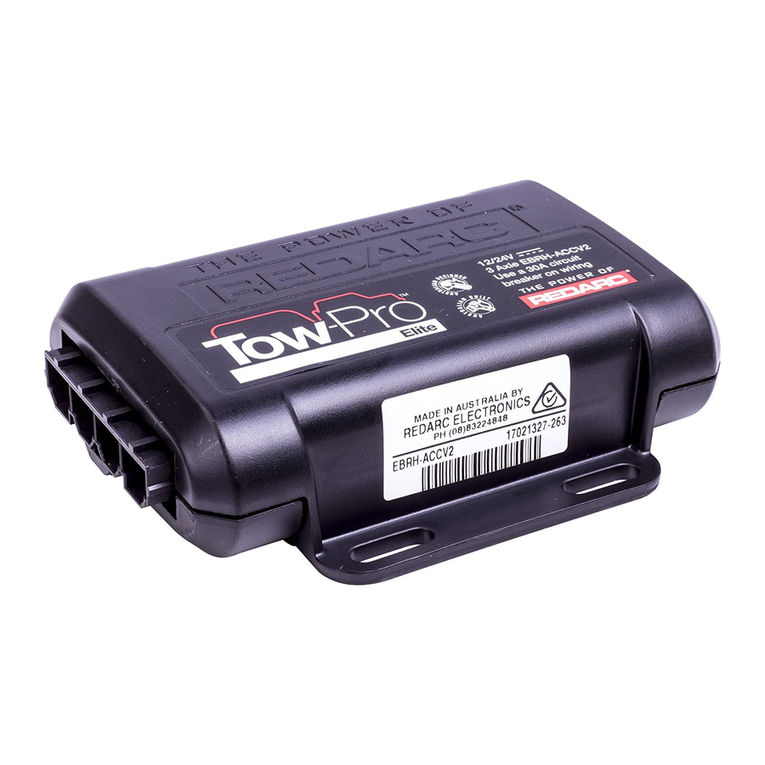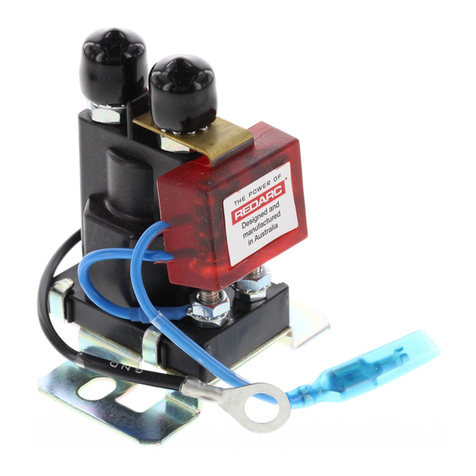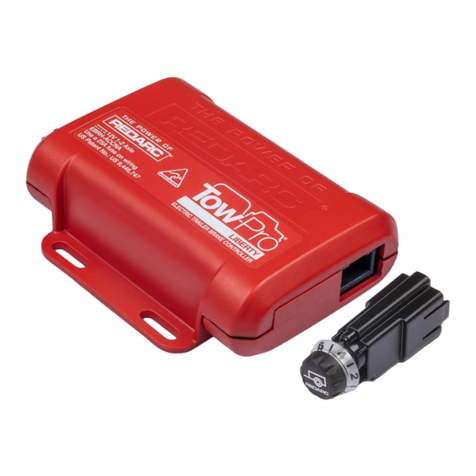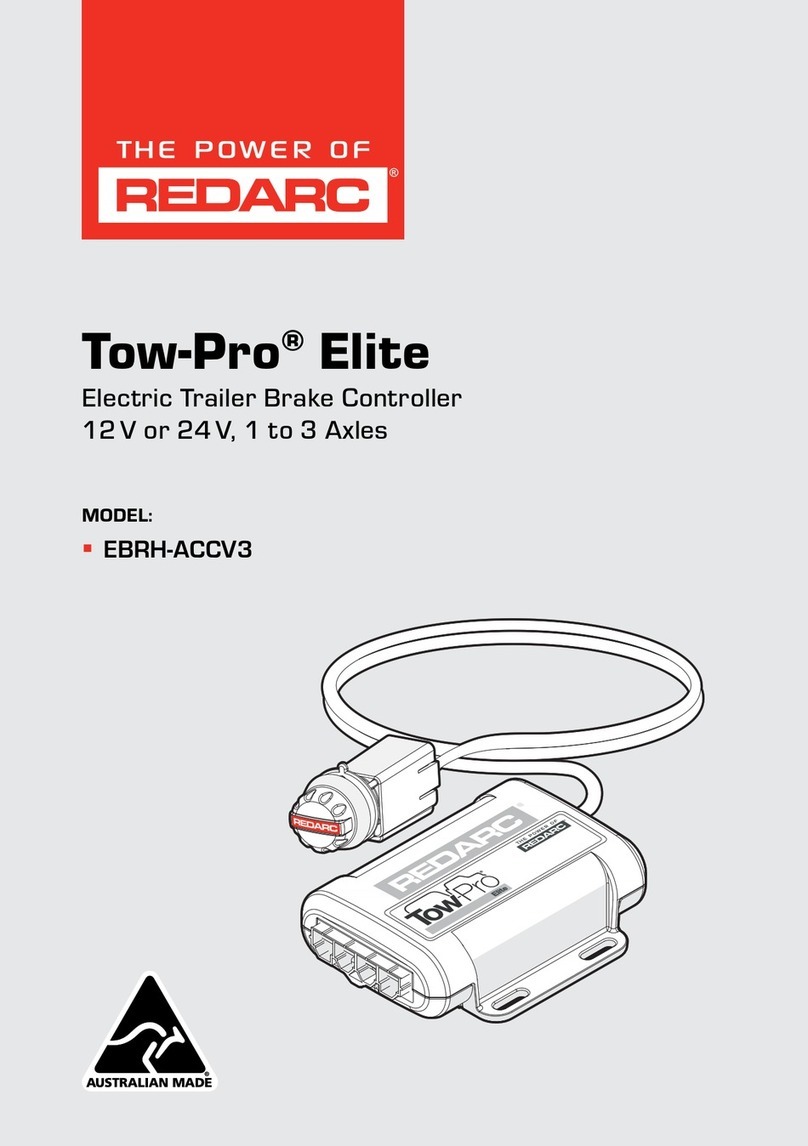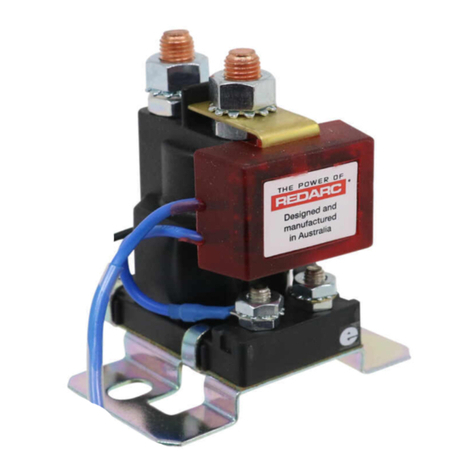
DE Deutsch | 5
DE DEUTSCH
PRODUKTFUNKTION
Der SBI12-LLD ist ein mikroprozessorgesteuerter Lasttrennschalter. Der
SBI12-LLD wurde speziell für den Einsatz in LiFePO4Batterieanwendungen
als System zum Schutz der Lithiumbatterie vor übermäßiger Entladung
durch Hilfslasten entwickelt, so dass die Hilfsbatterie über dem Niveau
bleibt, bei dem die interne Schutzschaltung aktiviert werden würde. Ein
Unterschreiten dieses Schwellenwerts würde viele Ladegeräte daran
hindern, die Batterie wieder aufzuladen.
Einfach ausgedrückt: Wenn die Hilfsbatterie zu stark entladen ist, schaltet der
Lasttrennschalter alle angeschlossenen Verbraucher ab. Wenn die Batterie
wieder über ein geeignetes Niveau ansteigt, stellt der Lasttrennschalter die
Stromversorgung der angeschlossenen Verbraucher wieder her.
WARN- UND SICHERHEITSHINWEISE
Bewahren Sie diese Anleitung auf. Sie enthält wichtige Sicherheitshinweise.
Nehmen Sie das System nur in Betrieb, wenn Sie diese Anleitung gelesen
und verstanden haben. REDARC empehlt, dass der SBI12-LLD, auf den
in diesem Handbuch verwiesen wird, von einer entsprechend qualizierten
Person installiert wird.
Haftungsausschluss: REDARC übernimmt keine Haftung für Verletzungen,
Verluste oder Sachschäden, die durch die unsachgemäße oder unsichere
Installation oder Verwendung seiner Produkte entstehen können.
WARNUNG: Gefahr durch explosive Gase: Das Arbeiten in der Nähe
einer Bleisäurebatterie ist gefährlich. Batterien erzeugen bei normalem
Betrieb explosive Gase. Aus diesem Grund ist es äußerst wichtig, bei jeder
Verwendung des Ladegeräts die Anweisungen zu befolgen.
ACHTUNG
NIEMALS rauchen oder Funken oder Flammen in der Nähe der Batterie oder
des Motors gelangen lassen. Dies kann zu einer Explosion der Batterie führen.
Vermeiden Sie unbedingt, dass Metallwerkzeuge auf eine Fahrzeugbatterie
fallen. Andernfalls besteht die Gefahr, dass die Batterie Funken schlägt
oder die Batterie oder andere elektrische Teile kurzgeschlossen werden,
was zu einer Explosion führen kann.
Legen Sie persönliche Metallgegenstände wie Ringe, Armbänder,
Halsketten und Uhren ab, wenn Sie mit einer Bleisäurebatterie arbeiten.
Eine Bleisäurebatterie kann einen Kurzschlussstrom erzeugen, der hoch
genug ist, um einen Ring oder ähnliches an Metall zu schweißen und
schwere Verbrennungen zu verursachen.
FUNKEN IN DER NÄHE EINER BATTERIE KÖNNEN DIE BATTERIE ZUR
EXPLOSION BRINGEN. UM DAS RISIKO VON FUNKENBILDUNG ZU
VERRINGERN, WENN DIE IN EIN FAHRZEUG EINGEBAUTE BATTERIE
AN DEN ISOLATOR ANGESCHLOSSEN WIRD, GEHEN SIE IMMER WIE
FOLGT VOR:
Platzieren Sie die Gleichstromkabel so, dass die Motorhaube, die Türen
und die beweglichen Motorteile nicht beschädigt werden.
Halten Sie sich von Lüfterügeln, Riemen, Riemenscheiben und anderen
Teilen fern, an denen sich Personen verletzen können.
Prüfen Sie, welcher Pol der Batterie mit dem Gehäuse geerdet (verbunden) ist.
Wenn der Minuspol am Gehäuse geerdet ist (wie bei den meisten Fahrzeugen),
siehe (1). Wenn der Pluspol mit dem Gehäuse geerdet ist, siehe (2).
(1) Bei einem Fahrzeug mit negativer Erdung schließen Sie die POSITIVEN
(roten) Klemmen des Batterietrennrelais an den nicht geerdeten
POSITIVEN (POS, P, +) Pol der jeweiligen Batterie an. Schließen Sie das
NEGATIVE (schwarze) Kabel an ein Metallteil des Rahmens oder des
Fahrzeuggehäuses fernab der Batterie an. Schließen Sie den Stecker nicht
an den Vergaser oder die Kraftstofeitungen an.
(2) Bei einem Fahrzeug mit positiver Erdung schließen Sie die NEGATIVEN
(schwarzen) Klemmen des Batterietrennrelais an den nicht geerdeten
NEGATIVEN (NEG / N / –) Pol der jeweiligen Batterie an. Verbinden Sie
die POSITIVEN (ROTEN) Klemmen mit den POSITIVEN (POS / P / +)
Polen der einzelnen Batterien. Schließen Sie den Stecker nicht an den
Vergaser, die Kraftstofeitungen oder Karosserieteile aus Metall an. Nur die
Starterbatterie sollte an das Gehäuse angeschlossen werden.
SICHERHEITSMASSNAHMEN:
Für einen sicheren Umgang mit Batterien:
Holen Sie sich stets Unterstützung durch eine andere Person, die Ihnen bei
der Arbeit mit der Batterie zur Seite steht.
Halten Sie reichlich frisches Wasser und Seife bereit, für den Fall, dass
Batteriesäure mit Haut, Kleidung oder Augen in Berührung kommt.
Tragen Sie einen vollständigen Augenschutz und Schutzkleidung.
Vermeiden Sie es, die Augen zu berühren, wenn Sie in der Nähe einer
Batterie arbeiten.
Wenn Batteriesäure mit Ihrer Haut oder Kleidung in Berührung kommt,
ziehen Sie die betroffene Kleidung aus und waschen Sie die betroffene
Hautstelle sofort mit Wasser und Seife. Wenn Batteriesäure in Ihre Augen
gelangt, spülen Sie das betroffene Auge sofort mindestens 10Minuten lang
mit ießendem kaltem Wasser aus und suchen Sie sofort einen Arzt auf.
HINWEIS
Risiko der Überladung. Stellen Sie sicher, dass die Abschaltspannung den
Angaben des Batterieherstellers entspricht.
Starter- und Zusatzbatterie sollten ähnliche chemische Eigenschaften
aufweisen, wenn sie über den Smart Start®SBI geladen werden.
Der SBI12-LLD erzielt die besten Ergebnisse, wenn die Batterie
regelmäßig gewartet wird. Dazu gehört unter anderem die Überprüfung
des Wasserstands und des spezischen Gewichts der Batterie. Weitere
Einzelheiten nden Sie im Handbuch des Batterieherstellers.
Zum Schutz des Fahrzeugsystems müssen Sicherungen oder
Schutzschalter mit einer geeigneten Leistung eingebaut werden.
Die Sicherungen müssen so nah wie möglich an der Batterie installiert
werden.
WICHTIG! Nehmen Sie KEINE Anschlüsse an den Steuerklemmen auf
der Vorderseite des Geräts vor. Das Anschließen an die Steuerklemmen
auf der Vorderseite der SBI kann zu Schäden am Gerät und/oder an den
angeschlossenen Geräten führen. Das Anschließen an die Steuerklemmen
führt zum Erlöschen der Garantie für das Gerät.
NICHT an die
Steuerklemmen
anschließen.
SPEZIFIKATIONEN
Systemspannung 12V Nominal
Volteinschaltung 11,0V
Voltausschaltung 10,5V
Einschaltverzögerung 10 Sekunden
Ausschaltverzögerung 2 Sekunden
Max. kontinuierlicher Strom 100Ampere
Max. Einschaltstrom 400Ampere
Ruhestrom <5mA
Betriebsstrom <0,1A
Abmessungen 75×70×80mm
Gewicht 200g
Garantie 2 Jahre
Normen CE, C-Tick, AS/NZS CISPR11:2004
Hauptbolzen-Drehmoment 5– 6,2Nm
Angegebene Spannungen sind ±100mV
